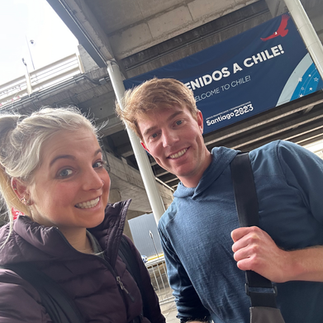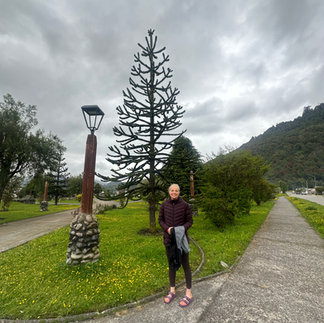Race Recap: Across Andes 2023-Dipping my toe into Ultra Racing
- Charlotte Backus
- Nov 26, 2023
- 9 min read
---

Embarking on my first ultra multi-day racing adventure, I stepped into the unknown with an open heart and a thirst for learning. The Across Andes race was more than a competition; it was a doorway to a part of the world I had never explored.
The Beginning:

The idea of traveling to a distant land and trying something entirely new is both exhilarating and daunting. I was fortunate to have Matthew, an experienced ultra-racer, by my side. His insights and assistance in preparation were invaluable, especially as we decided to compete as a duo.
The Decision:
Matthew discovered Across Andes about a year ago and signed us up. My journey in cycling has been one of constant exploration, and although I had not yet ventured into ultras, my experience with the Unbound 200 in 2022, despite its challenges, fueled my enthusiasm for this new endeavor.
Preparation:
Preparing for a self-supported, multi-day bike-packing race in cold weather was a complex puzzle. Packing everything needed for 3-5 days while ensuring efficiency in unpacking and repacking was a unique challenge. The process involved meticulous planning and several trial runs.
Packing Insights:
I shared a detailed video on my Instagram about our packing strategy. The key was to bring exactly what was necessary, considering the limited space and the need to be prepared for rain and cold weather. This meant investing in reliable rain gear and ensuring we had sufficient warm layers.
The Journey:
Our flight to Chile was an adventure in itself, complete with a lengthy layover and unexpected delays. But the excitement of the trip kept us energized, especially during the scenic 90-minute car ride to Coyhaique from Balmaceda.
Arrival:
Reaching the starting point was a relief and a thrill. The organization of the event was impressive, and our accommodation at the Patagonia bikers' place was ideally located amid stunning mountainous landscapes and a roaring river. Assembling our bikes and finalizing our setup, including a weigh-in (Matthew's bike at 46lbs/21kg and mine at 35lbs/16kg), heightened the anticipation.
One of the highlights was meeting fellow enthusiasts from around the globe, united by our passion for cycling.
With our preparations complete, it was time to face the challenge head-on and begin our journey through the Andes.
---
Day 1 - Sunrise Smiles and Cold Rains
6 AM: We rolled out right into a climb and soon realized we had overdressed. We quickly stopped, shed some layers, and continued on for 120km to the first refuel opportunity at El Blanco. Being Celiac and dairy-free always poses a challenge for me in terms of food, so I prepared beforehand with 5 sans meal bars, 2 sachets of beta fuel, and enough gels to get by. I didn't realize how quickly I would burn through all of this. The first refuel point had some suitable options; they had fruit, so I grabbed an apple and even found soy milk. Pouring soy milk into my camelback bladder might sound odd, but it was surprisingly refreshing. I've learned from long endurance riding that, while carbs are crucial for performance, listening to your body's cravings is also important. I also brought sport legs, prebiotics, Tums, probiotics, and enzymes to aid digestion since this wasn't just a one-day event. Optimal energy requires a well-functioning stomach.
For day races, I train with a specific carb intake each hour, but ultra racing required a different approach. I trained my body to sustain energy for longer periods, primarily staying in Zone 2 endurance, to become fat-adapted while also being able to consume a large number of calories upfront and last 4-6 hours before needing a refuel. In a few training sessions, I deliberately exercised in a depleted state to understand my threshold and developmental tools for pushing through pre-bonking states and recovering from moments of depletion. I didn't do this every ride, but planned certain sessions to understand my body. Everyone has different needs, so I always recommend working with a coach and nutritionist, especially with food allergies like mine.
The day was long, and although it started off great, the weather turned. Rain, wind, and cold set in.
We pushed towards our goal of reaching Checkpoint 1 at 245km. The rain escalated to a downpour that lasted hours. We persevered, focusing on reaching CP1. As night fell and we tackled a long false flat, we stopped to take some gels, which helped us immensely. We arrived at CP1 cold and wet, ready to rest for the night.
8:30 PM: Receiving a stamp at CP1 was satisfying, but our priority was to find food and dry shelter. The weather forecast for the next day looked even worse, with constant cold, wet rain. Our rain gear had its limits. There was food at CP1, but none that I could eat, so we needed an alternative. That's when we experienced the incredible hospitality of the Chilean people. Matthew smartly inquired if there was anywhere I could find suitable food, and we were directed to an adorable house. The owners kindly offered us food and a place to sleep on their wooden loft floor. We hung our clothes to dry as much as possible, planning to wake up early and ride in the snow to avoid the rain.
---
Day 2 - Rain, Rain, and More Rain… Into the High Mountains
3 AM: I woke up as ready as ever. It was a bit earlier than our planned start, but I was eager to get moving. We packed up our half-dried things and headed out into the cold, enjoying the fluffy snow in the dark. About 5km in, Matthew realized he had left his wallet - which had all our money and cards - back in the warm loft. It was frustrating to lose 20 minutes returning for it, but better then than later, especially with the challenging climbs ahead.
After retrieving the wallet and pressing on, the sun began to rise, turning the snow into rain. We got drenched but stayed dry underneath. The rain eventually subsided, but that's when I started feeling an odd pain in my right knee, perhaps from the unfamiliar combination of pulling a heavy load, riding with leggings, and wearing rain pants. Hoping that continuous pedaling would help, we pushed on to a gas station for a refuel before tackling a significant mountain ascent to Checkpoint 2.
Unfortunately, there was no fruit at the station, and after 3 hours of riding without food, I desperately needed carbs. I settled for coffee, baby food, and peanuts, wanting to save my last sans bar and gels for emergencies. The baby food turned out to be roasted beef, not the best taste, but it was all I could eat, so I mixed it with peanuts. Despite my stomach’s protests, it provided the necessary nutrients because we needed to keep moving to generate heat in the increasingly desolate terrain.
However, my knee pain worsened, swelling and causing more trouble. The weather deteriorated further, and with the extra water, we needed more bathroom breaks, which meant removing layers in the cold. We were soaked, and my aching knee slowed us down, making it hard to stay warm. We decided to push to the mountain's top and find a dry place for the night, as descending in the wet and cold night was not advisable.
The highlight of the day was finding a hostel, indicated by about six other racers' bikes parked outside. Chile's hostels, with their amazing hospitality, became a sanctuary for us. The owners opened their homes, cooked meals, and supported everyone on their journeys. The food was unlike anything I expected, with dishes like rice and fish, pasta and meat sauce, bread and pico, chicken and rice, and salad.
We arrived around 2 PM, having covered only 100km. Hypothermia was a looming threat, and my knee was becoming a serious concern, hindering my ability to pedal. We chose safety and recovery, deciding to wait out the worst of the storm and start again at 6 AM the next day. Grateful for the warmth of a fire, we fell asleep among fellow racers, escaping the cold for the night.
---
Day 3 - Knee Pain Agony and a Thrilling Downhill to a German-Like Town
6:30 AM: We woke up, had breakfast (mine included a big bowl of rice and oranges), and set out in cloudy weather towards CP2, 200km away. The morning gifted us with a beautiful 20-mile climb. My knee, however, nagged more, particularly during the descent, which was a mix of smooth pavement and freezing gravel. Despite the cold, we were exhilarated by the corkscrew downhill leading us into a jungle-like territory. It was a stark contrast from the Colorado plains-like environment we had left behind.
As we hit the flat section, my knee became tender. During a bathroom break, I realized I couldn't bend my knee. The night before the race, I had hit my knee on the bedpost in the dark, which might have caused some inflammation and filled my bursa sacs with fluid.
Every pedal stroke brought agony. We stopped at a charming town by a lake, originally connected to the ocean, and learned that many settlers had come from Germany during WWII. This explained the slight German influence in the town's atmosphere and language. Unfortunately, resting only worsened my knee pain.
We refueled at a gas station and prepared for the last 70km to CP2. We had learned earlier that Checkpoint 3 was removed due to rain and flooding. Hoping to reach CP2 that day, we set off, only for my knee to fail on rough gravel. In tears and unable to continue, I faced the tough decision to prioritize my long-term health over immediate goals.
We returned to the town to rest for the night, finding an Airbnb and some cats for comfort. My knee was too swollen to bend fully, and my left knee was strained from compensating. Despite our efforts to make it comfortable, it was clear that continuing was not an option.
With 425km back to the finish and the storm still looming, we hoped to still make the cut-off time, even if we couldn't reach CP2. We planned to return after the storm, hoping that some rest would allow my knee to recover enough for the journey back.
---
Day 4 - No Bueno
We woke up later and rode 44km back to the fish town. Matthew had booked an Airbnb there for a day of rest before we attempted the big mountain climb to the finish. After waiting out the morning downpour, we headed to the fish town. My knee was manageable, but deep down, I knew it was seriously injured and would require rehab. I tried to listen to my body, telling myself we just had to take it easy and make it to the mountain top the next day.
In the fish town, we found a cozy cabin Airbnb hosted by a kind Swiss man. It was a great place to rest, shower, and sleep. I found a big bag of peas for my knee and stocked up on food for the next day's climb. Dinner at a local cafe introduced us to some excellent fresh seafood, and we decided to just enjoy ourselves and make the best of the trip. Many had withdrawn from the race due to the cold and rain, so just pushing through and staying safe was an achievement.
Matthew's patience and support through my moments of agony and tears were invaluable. He has taught me so much and understood the disappointment of wanting to continue but needing to listen to the body.
Day 5- Making Lemonade out of lemons
Waking up fairly early, I made yummy rice pudding, and we set out with the goal of reaching the mountain top for easier access to a shuttle. The weather finally turned in our favor with the sun coming out, instantly lifting our spirits. I was ready to conquer the climb, but just a few pedal strokes in, my knee gave out, unable to bear any pressure without my patella straining and beginning to dislocate due to swelling. It was clear that riding was over. I sat at a bus stop, crying and coming to terms with the situation. We need to listen to our bodies, and mine was clearly saying no more.
Matthew sat with me, understanding the rollercoaster of emotions typical in ultra racing. This first ultra experience was a steep learning curve, not just in racing but in life and relationships. Matthew taught me to appreciate the journey and the beauty around us, even in difficult moments.
Though I initially saw this as a failure, being driven back by the emergency crew made me realize this was just the start of my ultra journey and a new chapter in life. We met generous people who showed us their culture, and we spent the day admiring the riders and even more cats! The personal experience of this culture was something pictures could never capture. It was an incomplete race, but it fueled my desire for the next challenge.
Success often comes from challenges and incomplete endeavors. They are hard at first but ultimately contribute to our growth and learning.
This first ultra opened many doors for my future goals. We not only raced but also immersed ourselves in the culture and met incredible people. The journey and the connections made along the way are indescribable. We're already signed up for The Goats in Portugal next year!
Across Andes was a well-organized event, caring for every rider. The after-party was a joyful gathering of people from all over the world, laughing and sharing stories. This experience was truly special.



























































































Comments